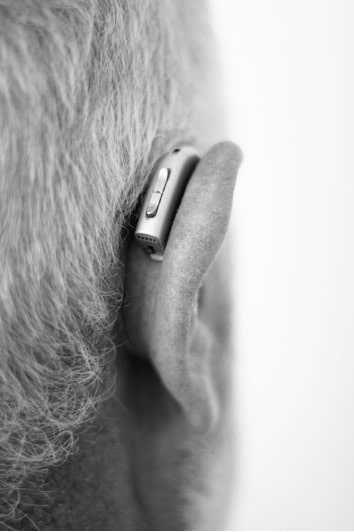A Guide to Ear Wax for Hearing Aid Wearers
If you are a hearing aid wearer, it’s important to know how earwax build up can impact on your hearing aids and your overall ear health. Hearing aids are fantastic devices that help many people but they may cause earwax impaction. It’s important for hearing aid users to have their ears cleaned regularly to prevent wax build up preventing the hearing aid from working properly.
Ear Wax and Hearing Aids
Earwax is a natural substance that our bodies produce to keep our ears healthy. Earwax is acidic and if you have naturally softer wax,this combination can have a negative impact on your hearing aids. Hearing aids are electronic and they can fail when exposed to the acid and moisture of earwax. Approximately 60 to 70% of devices returned to manufacturers for repair have been damaged by ear wax contamination. These pieces of equipment can be expensive to repair or replace. Preventing the hearing aid from deteriorating and maintaining good aural health is important to prevent damage to your hearing aids.
Impacted earwax can also have an impact on your hearing aids performance. If you’re experiencing a whistling or squealing noise inside your ear, it may be because of impacted earwax. Sound travels down the ear canal but is rebuffed by a build up of wax which is delivered back into the hearing aid microphone, creating a feedback loop of sound.

Ear Wax and Hearing Aids
Earwax is a natural substance that our bodies produce to keep our ears healthy. Earwax is acidic and if you have naturally softer wax,this combination can have a negative impact on your hearing aids. Hearing aids are electronic and they can fail when exposed to the acid and moisture of earwax. Approximately 60 to 70% of devices returned to manufacturers for repair have been damaged by ear wax contamination. These pieces of equipment can be expensive to repair or replace. Preventing the hearing aid from deteriorating and maintaining good aural health is important to prevent damage to your hearing aids.
Impacted earwax can also have an impact on your hearing aids performance. If you’re experiencing a whistling or squealing noise inside your ear, it may be because of impacted earwax. Sound travels down the ear canal but is rebuffed by a build up of wax which is delivered back into the hearing aid microphone, creating a feedback loop of sound.
Our Ears’ Self Cleaning Process
Wax plays an important role in our ear canal. Ear wax helps to prevent foreign bodies from entering the ear canal and potentially damaging the eardrum. As we move our jaw, earwax is loosened and naturally exits the ear via a migrating skin layer. In this way, ears are self-cleaning.
However, when wearing hearing aids, earwax cannot move out of the ear canal as easily. The hearing aids block this process, can push wax deeper into the ear canal and ear wax can build up inside of the ear and become impacted.
Looking After Your Hearing Aids
Problems with earwax and hearing aids may be prevented with thorough and regular care. When you are fitted with a hearing aid, you should be shown how to use the wax trap. This is designed to catch excess wax and prevent it from returning into the ear. You should change your wax trap at least once every three months.
Hearing aid inserts or moulds and wax guards need to be cleaned and dried daily. You can do this by detaching them and soaking them in a mild soapy solution, or by brushing them with a small brush provided by the hearing aid manufacturer once the aids are left overnight and the wax dries.
Some other tips for taking care of your hearing aids include:
- Keep your hearing aids away from heat and moisture
- If your hearing aids do get wet, wipe any moisture away with a tissue or dry cloth
- Turn off your hearing aids and put them in their case when they are not in use
- Handle your hearing aids with care and don’t drop them
- Remove your hearing aids before using any cosmetic or personal care items that may damage them, such as hairspray, perfume, sunscreen, aftershave or insect repellent.
Regular Ear Wax Removal
Hearing aid users are more likely to experience ear wax impaction. It is important to closely monitor earwax and know when to seek help with cleaning your ears. If you feel like your hearing aid isn’t working as well as it should, if you are experiencing a whistling ‘feedback’ noise, or your ears feel blocked or full, you should consider earwax removal with Earworx.
Getting your ears professionally cleaned is the safest way to ensure your ears remain free of blockages and help maintain good aural health. When you visit an Earworx clinic, a Registered Nurse will closely examine your inner ear using specialised glasses known as ‘loupes’ and determine if you require earwax removal by microsuction.
At Earworx, we use the safe and painless micro-suction technique to remove earwax. Micro-suction acts like a vacuum to remove excess ear wax. It is recommended as best practice and is the safest technique by specialists in ear health. Micro-suction is a dry technique, making it a good option for people with perforated eardrums, exostoses or ‘surfers ear’, skin conditions, ear infections and diabetes.
We recommend that people who use hearing aids visit Earworx to have their ears checked for wax build up 6 monthly. If no excess wax is found, you receive a discounted rate on your visit.
Avoid home remedies such as ear candles, cotton buds and by inserting implements into your ear canal. These items can push wax further back and may worsen symptoms and can cause trauma to your ear canal or ear drum.
Book an appointment with Earworx today.




